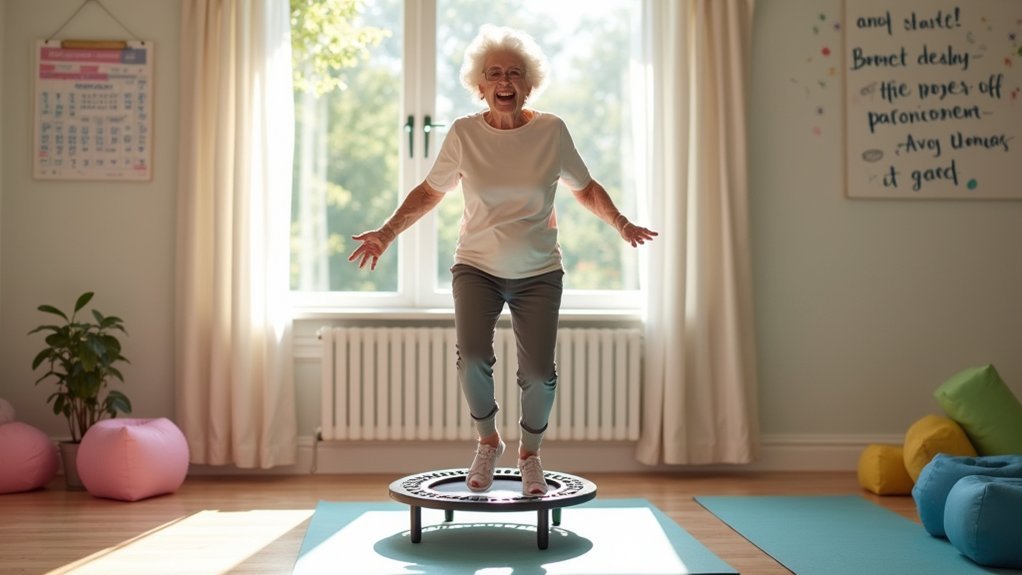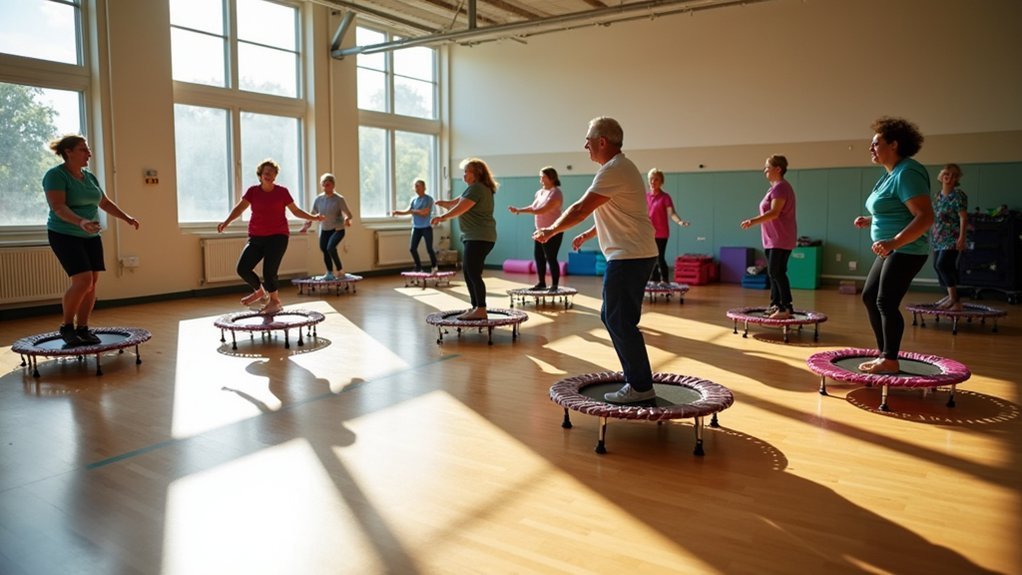Medicare covers medically necessary bone-strengthening exercises through Part B when prescribed by your doctor with a documented plan of care. You’ll pay a 20% coinsurance after meeting your deductible. Coverage requires proof of medical necessity, typically with an osteoporosis diagnosis or significant risk factors. While rebounding exercises can help improve bone density, Medicare generally won’t cover equipment like mini trampolines. The specifics of coverage depend heavily on proper documentation and provider qualifications.
The Science Behind Rebounding and Bone Density

While many people think of bone mass as static, your skeleton constantly rebuilds itself through a process called remodeling. Rebounding, or exercising on a mini-trampoline, creates beneficial gravitational forces that stimulate this process, enhancing bone density where you need it most.
Research confirms that weight-bearing exercises like rebounding greatly improve bone mineral density, particularly in postmenopausal women facing osteoporosis risk. Just 10-20 minutes daily can strengthen your bones and reduce fracture risk.
What makes rebounding ideal for bone health is its low-impact nature. You’ll get the benefits of weight-bearing exercise without stressing your joints.
Additionally, the muscle engagement required during rebounding improves coordination and balance—further protecting you from falls that could lead to fractures.
Medicare Part B Coverage for Exercise Therapies
Medicare Part B offers coverage for physical therapy services that include bone-strengthening exercises when they’re deemed medically necessary for conditions like osteoporosis.
You’ll need a doctor’s referral and a documented plan of care that meets Medicare’s eligibility requirements, including supervision by qualified healthcare professionals.
To receive these benefits, you must guarantee proper documentation of your progress and medical necessity, with services typically subject to your annual deductible plus a 20% coinsurance payment.
Physical Therapy Services Explained
When your doctor determines that physical therapy is medically necessary, Part B of your Medicare plan can become a valuable resource for bone density exercise treatments. These services are particularly beneficial if you’re managing osteoporosis or recovering from bone-related surgeries.
Medicare covers a range of supervised therapies designed to improve your strength, balance, and mobility—all critical for preventing fractures when dealing with bone density concerns. To access these benefits, you’ll need a doctor’s referral confirming medical necessity.
After meeting your annual Part B deductible ($257 in 2025), Medicare pays 80% of the approved amount for your physical therapy sessions.
To avoid unexpected costs, always verify that your therapist is enrolled in Medicare before beginning treatment.
Coverage Eligibility Requirements
Three key requirements determine your eligibility for Medicare-covered bone density exercise therapies. For Medicare Part B to cover your osteoporosis-related exercise therapies, you must have documentation proving they’re medically necessary, be diagnosed with osteoporosis or show significant risk factors, and receive services from a Medicare-participating provider.
| Eligibility Factor | Medicare Requirement |
|---|---|
| Medical Necessity | Documented by healthcare provider |
| Diagnosis Status | Confirmed osteoporosis or high risk |
| Provider Type | Medicare-participating therapist |
Your extensive treatment plan must specifically address bone density improvement through targeted exercises. Remember that coverage eligibility doesn’t guarantee zero expenses—you’ll likely have some out-of-pocket costs depending on your specific plan. Medicare Advantage plans may offer different coverage levels for these services, so verify your benefits before beginning treatment.
Supervision and Documentation Standards
For your bone density exercise therapy to maintain Medicare Part B coverage, you’ll need to follow specific supervision and documentation standards throughout your treatment.
Medicare requires that a qualified healthcare provider supervises your exercise therapy sessions, especially if you’re managing osteoporosis.
Your medical records must clearly establish medical necessity, with your healthcare provider documenting your condition and why the exercise therapy is required for your recovery.
During treatment, detailed progress notes tracking your improvement are essential for continued Medicare coverage.
These documentation requirements aren’t just paperwork—they’re proof that your therapy is working.
Your provider will regularly assess your strength, balance, and mobility improvements, creating a record that justifies ongoing treatment.
Without proper supervision and thorough documentation, Medicare may deny coverage for your bone density exercise program.
Qualifying for Medicare-Covered Rebounding Therapy
Although many seniors enjoy rebounding therapy as part of their fitness routine, Medicare coverage for this beneficial exercise requires meeting specific qualification criteria.
You’ll need a documented diagnosis of osteoporosis or significant bone density loss from your healthcare provider to qualify for Medicare coverage.
Your doctor must certify that rebounding therapy is a medical necessity for your condition, not just a fitness preference. This documentation should clearly establish how this low-impact exercise specifically addresses your bone health concerns.
Medical necessity, not personal preference, must be documented by your physician to qualify for rebounding therapy coverage.
Medicare typically covers these services under Part B as outpatient therapy when properly prescribed.
Before starting treatment, verify your coverage details and obtain any required pre-authorization. Your healthcare provider can help navigate the paperwork needed to demonstrate that rebounding therapy is an essential component of your bone health treatment plan.
Rebounding Equipment: What Medicare Will and Won’t Pay For

Many seniors are surprised to learn that Medicare generally doesn’t cover rebounding equipment like mini trampolines.
While Medicare covers bone density scans to diagnose osteoporosis, it typically won’t pay for exercise aids used to improve your condition.
Medicare’s coverage focuses on durable medical equipment that’s medically necessary, such as walkers or wheelchairs—not fitness items.
Your Medicare plan primarily reimburses items that directly treat medical conditions rather than prevent them.
There’s a narrow exception: if your doctor prescribes specific rebounding exercises for rehabilitation purposes, you might’ve a case for coverage.
However, this is rare. Before purchasing any equipment, check with your provider about possible coverage for rebounding equipment, as most patients end up paying out-of-pocket for these bone-strengthening tools.
Medical Necessity Documentation Requirements
Four essential elements must be present in your medical documentation to secure Medicare coverage for bone density tests.
First, your healthcare provider needs to clearly document specific risk factors for osteoporosis, such as advanced age, hormonal changes, or previous fractures.
Second, medical records should include evidence of related conditions like osteopenia, sudden back pain, or family history of osteoporosis.
Third, documentation must detail any medications affecting bone health, particularly long-term steroid use, which might justify more frequent testing than Medicare’s standard two-year interval.
Finally, your patient history should be thorough, including recent imaging results.
The diagnosis must align precisely with Medicare coverage guidelines to prevent claim denials. Your healthcare provider’s meticulous documentation of medical necessity is your best assurance of obtaining Medicare coverage for your bone density test.
Preventative vs. Therapeutic Rebounding Coverage

Medicare distinguishes between preventative rebounding exercises, which typically aren’t covered, and therapeutic rebounding prescribed for specific medical conditions, which may qualify for coverage with proper doctor documentation.
Your physician must clearly document medical necessity, including how rebounding specifically addresses your bone density concerns, in order for Medicare to evaluate covering these services under Part B.
While Medicare generally won’t reimburse for personal rebounding equipment like mini-trampolines, your Medicare Advantage plan might offer fitness benefits that partially cover such equipment costs.
Coverage Criteria Differences
When seeking coverage for bone density-related services, you’ll notice fundamental differences between preventative and therapeutic approaches under Medicare guidelines.
For preventative bone density tests, Medicare Part B covers screenings once every 24 months if you’re at risk for osteoporosis due to age or medical conditions. Your doctor must document this risk, making the test a covered preventive service.
In contrast, therapeutic exercises like rebounding aren’t covered unless they’re part of a medically necessary physical therapy plan. The key difference is ongoing medical necessity documentation for therapeutic services versus risk certification for preventative testing.
Medicare Advantage plans might offer additional exercise program benefits, but coverage for specific therapeutic rebounding varies by plan. Regular exercise programs are generally not covered unless they’re prescribed as medically necessary treatment.
Required Doctor Documentation
Because Medicare distinguishes sharply between preventative and therapeutic services, proper physician documentation becomes critical for securing coverage for bone density exercises.
Your doctor must clearly document medical necessity for either type of service. For preventative coverage, your doctor’s documentation should establish that you’re at risk for osteoporosis or have a diagnosis requiring bone density exercises.
Similarly, therapeutic rebounding exercises need documentation justifying their necessity for improving your balance and bone strength.
Without sufficient documentation, Medicare will likely deny coverage for both preventative and therapeutic exercises.
To support your claims, maintain records of your doctor’s recommendations and relevant test results.
Remember that thorough communication with your healthcare provider guarantees the documentation meets Medicare’s specific requirements, maximizing your chances of coverage approval.
Rebounding Equipment Reimbursement
Two distinct categories govern Medicare’s approach to rebounding equipment reimbursement.
Medicare typically doesn’t cover rebounding equipment for general exercise purposes, even if it improves bone density. However, if your doctor determines rebounding is medically necessary for rehabilitation following an injury or medical condition, you might qualify for coverage under therapeutic benefits.
To maximize your chances of Medicare covering rebounding equipment:
- Obtain specific documentation from your healthcare provider linking the equipment to your bone density rehabilitation needs.
- Verify that your rehabilitation plan meets Medicare’s definition of medical necessity.
- Check with your specific plan for detailed coverage options, as Medicare Advantage plans sometimes offer additional benefits for therapeutic exercise equipment.
Remember that preventative rebounding usually falls outside Medicare’s coverage scope unless clearly prescribed for therapeutic purposes.
Medicare Advantage Plans and Additional Exercise Benefits
Although Original Medicare provides basic coverage for bone health services, Medicare Advantage plans often go further by offering enhanced exercise benefits that specifically target bone density improvement.
Your MA plan must cover medically necessary exercise programs related to bone health, but many plans include additional wellness benefits like gym memberships or specialized fitness classes designed to strengthen bones and prevent falls.
If your doctor recommends physical therapy to improve strength and balance, your Medicare Advantage plan will typically cover these exercise therapy sessions when deemed medically necessary.
Some MA plans even offer specialized osteoporosis prevention programs not available through Original Medicare.
To maximize your bone health benefits, review your individual MA plan’s benefits carefully and consult with your healthcare provider about which covered exercise options might work best for your specific needs.
Combining Physical Therapy With Rebounding Activities
While physical therapy forms the cornerstone of Medicare-covered bone health treatments, integrating rebounding activities can greatly enhance your results.
When your doctor prescribes physical therapy for osteoporosis, Medicare Part B provides coverage for these medically necessary services, which can include rebounding exercises on mini-trampolines.
The combination offers three notable benefits:
- Low-impact cardiovascular exercise that stimulates bone density without stressing fragile joints
- Enhanced muscle strength surrounding vulnerable bones, providing better support and stability
- Improved balance and coordination that considerably reduces your fall risk
Before adding rebounding to your exercise routine, consult your healthcare provider to verify it’s appropriate for your specific bone health concerns.
When properly integrated, this combination creates a thorough approach to building and maintaining bone density.
Medicare Coverage Limitations for At-Home Exercise Programs
While Medicare provides coverage for certain bone-density treatments in clinical settings, you’ll find that at-home exercise programs specifically designed for osteoporosis prevention aren’t typically covered.
Your personal exercise equipment like rebounders, resistance bands, or balance platforms won’t qualify for Medicare reimbursement, regardless of their therapeutic benefits.
You should consider exploring Medicare-approved physical therapy sessions instead, which may incorporate similar exercises but must be prescribed by your physician as medically necessary for a specific condition.
At-Home Program Exclusions
Despite the recognized benefits of regular exercise for bone health, Medicare draws a clear line when it comes to at-home programs.
You’ll find that Medicare doesn’t cover exercise routines specifically designed for bone density improvement when performed at home, even if recommended by your doctor.
While Medicare Part B does provide coverage for:
- Medically necessary physical therapy sessions in clinical settings
- Certain outpatient rehabilitation services related to osteoporosis treatment
- Bone density tests and screenings when ordered by a physician
At-home exercise programs fall outside these parameters and aren’t considered medically necessary under Medicare guidelines.
You’ll need to pay out-of-pocket for home-based bone strengthening routines, including any specialized equipment or instructional materials.
It’s important to discuss with your healthcare provider how these self-funded activities can complement your covered treatments.
Equipment Coverage Gaps
The gap in Medicare coverage extends beyond program participation to include essential equipment needed for effective bone density exercises at home.
While Medicare Part B covers physical therapy sessions with licensed professionals, it won’t pay for the weights, resistance bands, or home gym machines you’ll need to maintain your bone health between appointments.
Unfortunately, standard exercise equipment doesn’t qualify as durable medical equipment (DME) under Medicare guidelines. This creates significant coverage limitations for those managing osteoporosis through at-home exercise regimens.
You’ll likely need to explore alternative funding options for your exercise equipment needs. Consider health savings accounts or private insurance supplemental plans that might offer better support.
Medicare does cover some supervised group exercise programs specifically for seniors, but the equipment coverage gaps remain a challenge for thorough osteoporosis management at home.
Provider Qualifications for Medicare-Reimbursed Rebounding Therapy
Healthcare professionals seeking to offer Medicare-reimbursed rebounding therapy must meet strict qualification requirements.
You’ll need to verify your provider is a licensed healthcare professional, specifically a physical or occupational therapist with specialized training in fall prevention and balance techniques.
For Medicare to cover your rebounding therapy, these three criteria must be met:
- The therapy must be prescribed by a doctor as part of your thorough treatment plan for conditions like osteoporosis.
- Your provider must document medical necessity through detailed patient assessments and progress notes.
- All therapeutic practices must focus on low-impact exercises that specifically promote bone density improvement.
Remember that facilities offering these services must accept Medicare and comply with all applicable state and federal regulations governing therapeutic exercise programs.
Supplemental Insurance Options for Expanded Exercise Coverage
Several insurance options exist beyond Original Medicare to help cover bone-strengthening exercise programs.
Medicare Advantage (MA) plans often include additional coverage for exercise programs specifically designed to improve bone health that Original Medicare doesn’t typically cover. These plans may provide access to structured exercise classes focusing on strength training and fall prevention through extensive wellness programs.
If you’re looking for help with out-of-pocket costs related to rehabilitation services or exercise therapy for osteoporosis, supplemental insurance like Medigap might be worth considering. Coverage varies greatly between providers and plan types, so you’ll need to review your specific plan details carefully.
Some supplemental insurance and MA plans even offer premium reductions or other incentives when you participate in approved exercise programs, making it easier to maintain your bone health.
Appealing Medicare Denials for Bone Density Exercise Programs
When your Medicare claim for a bone density exercise program gets denied, you’ll need to navigate a structured appeals process to potentially reverse this decision.
Medicare denials can be overturned with the right approach and proper documentation of medical necessity.
To build a successful appeal:
- Gather thorough documentation from your healthcare provider explaining how the bone density exercise program specifically addresses your osteoporosis management needs.
- Submit your appeal within 120 days, including all relevant test results and treatment plans that demonstrate preventive care benefits.
- Consider enlisting a Medicare advocate who understands the nuances of coverage guidelines and can help strengthen your case.
Remember to emphasize how the exercise program helps prevent fractures—this connection to preventive care may be essential for your appeal’s success.
Frequently Asked Questions
What Diagnosis Covers Bone Density for Medicare?
Medicare covers bone density tests for you if you’re diagnosed with osteoporosis, low estrogen levels, primary hyperparathyroidism, or if you have X-ray evidence of osteopenia, vertebral fractures, rheumatoid arthritis, or diabetes.
What Is the Best Exercise Machine for Bone Density?
Weight-bearing machines like treadmills or ellipticals are best for your bone density. You’ll also benefit from resistance training equipment. For maximum impact, try stair climbers or vibration platforms combined with regular strength training.
What Osteoporosis Treatments Are Covered by Medicare?
Medicare covers your injectable medications like Prolia under Part B, home health nurse injections, self-administered drugs under Part D, physical therapy when medically necessary, and surgical procedures related to osteoporosis under Part A.
How Much Should a Bone Density Test Cost?
Without insurance, you’ll pay around $719 for a bone density test. With insurance, expect to pay $160-$175. If you’re on Medicare, you’ll typically receive this test at no cost every 24 months.
In Summary
You’ll need to weigh your options carefully when seeking Medicare coverage for rebounding therapy. While Part B may cover supervised exercise programs with proper documentation of medical necessity, at-home equipment typically isn’t covered. Work closely with your qualified healthcare provider, consider supplemental insurance, and don’t hesitate to appeal denials if you believe you qualify for these bone-strengthening benefits.




Leave a Reply